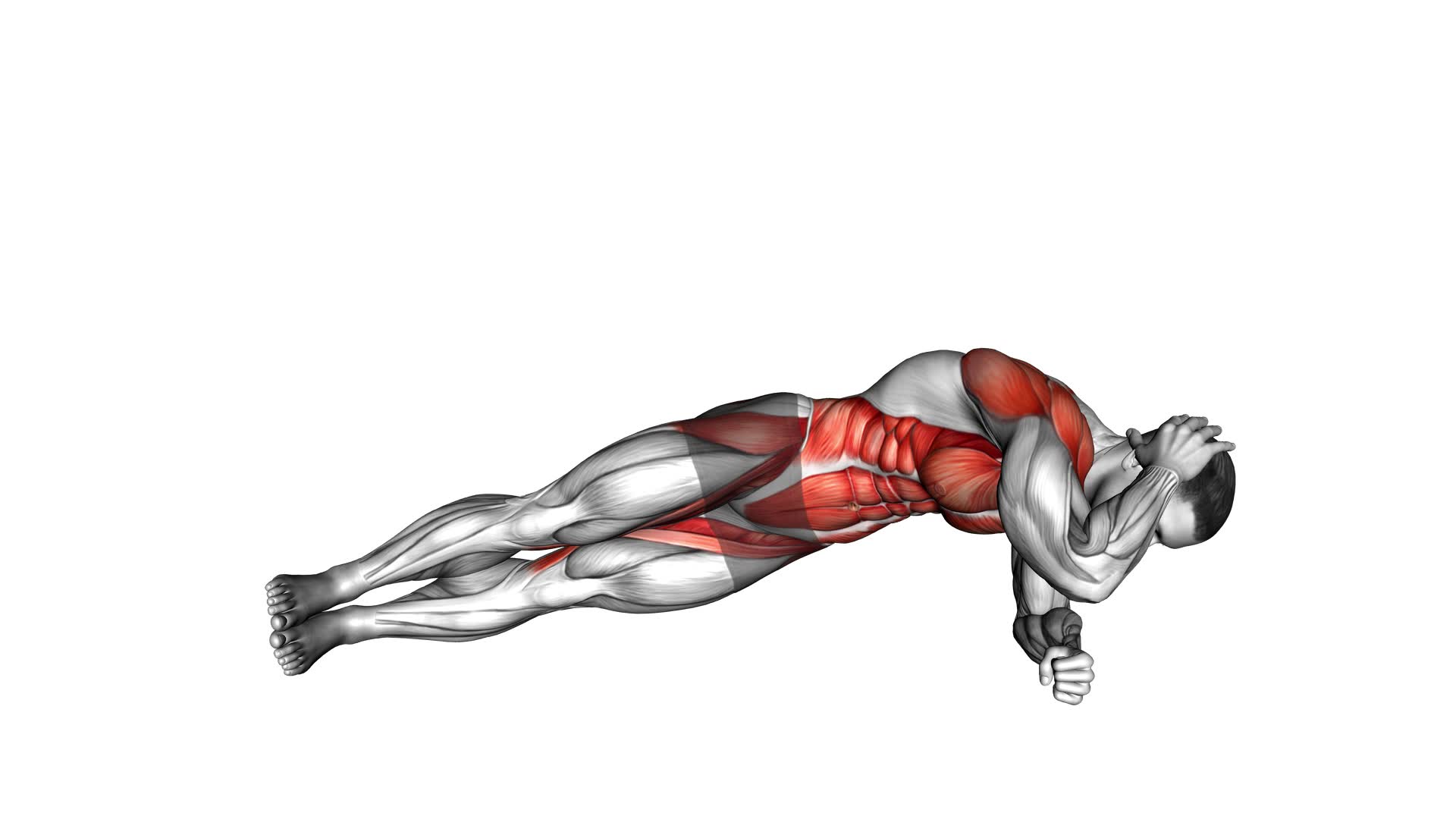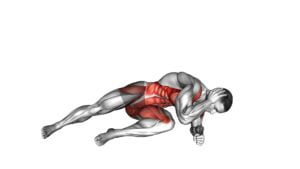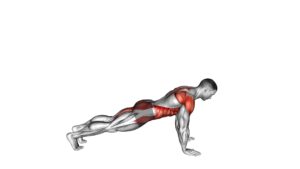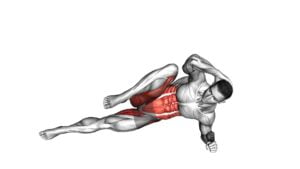Side Plank Raise and Crunch (male) – Video Exercise Guide & Tips

Are you looking to level up your core workout? Check out the Side Plank Raise and Crunch!
Watch This Exercise Video
This exercise targets your obliques, shoulders, and abs all at once. It's a challenging move, but with proper form and technique, you'll see amazing results.
In this video exercise guide, we'll walk you through each step, offering tips and modifications along the way.
Get ready to feel the burn and sculpt a stronger, more defined midsection. Let's get started!
Key Takeaways
- Side Plank Raise and Crunch targets obliques, shoulders, and abs.
- Proper form and technique are crucial for maximizing the benefits of this exercise.
- Engaging core muscles throughout the movement is essential for stability and strength.
- Modifications and advanced variations can be incorporated to increase the intensity of the exercise.
Benefits of Side Plank Raise and Crunch
Get stronger and more toned by incorporating the Side Plank Raise and Crunch into your workout routine. These exercises are highly effective for core strengthening and oblique activation.
The Side Plank Raise specifically targets your obliques, which are the muscles on the sides of your abdomen. By performing this exercise, you'll be able to strengthen and define these muscles, giving you a more sculpted waistline. Additionally, the Side Plank Raise also engages your glutes, shoulders, and upper back, providing a full-body workout.
The Crunch, on the other hand, primarily targets your rectus abdominis, which is the muscle responsible for the six-pack appearance. By incorporating the Crunch into your routine, you'll be able to strengthen and tone your abs, giving you a more chiseled midsection. This exercise also engages your hip flexors and lower back to a certain extent, providing a comprehensive core workout.
By including the Side Plank Raise and Crunch in your routine, you won't only improve your core strength and stability but also enhance your overall physique. These exercises are versatile and can be modified to suit your fitness level.
Now, let's move on to the next section where we'll discuss the proper form and technique for performing the Side Plank Raise and Crunch.
Proper Form and Technique for Side Plank Raise and Crunch
To perform the Side Plank Raise and Crunch exercise with proper form and technique, there are three key points to focus on.
First, engage your core muscles throughout the entire movement to maintain stability and control.
Second, ensure your arms and legs are properly aligned, with your supporting arm directly beneath your shoulder and your top leg stacked on top of the bottom leg.
Lastly, remember to breathe steadily and exhale as you crunch, maximizing the effectiveness of the exercise.
Core Muscle Engagement
To engage your core muscles properly during the Side Plank Raise and Crunch exercise, consistently focus on maintaining a stable and aligned position throughout the movement.
Core stability and core strength are essential for performing this exercise effectively. Start by positioning yourself in a side plank with your elbow directly beneath your shoulder and your legs stacked on top of each other.
Engage your core by squeezing your abdominal muscles and lifting your hips off the ground, creating a straight line from your head to your heels. As you raise your top leg and arm, ensure that your body remains stable and aligned. Avoid letting your hips sag or rotate.
Arm and Leg Alignment
Maintain proper arm and leg alignment for optimal form and technique during the Side Plank Raise and Crunch exercise by ensuring your elbow is directly beneath your shoulder and your legs are stacked on top of each other.
Here are three key points to remember regarding arm and leg coordination in this exercise:
- Elbow beneath shoulder: Position your elbow directly beneath your shoulder to create a strong and stable base. This alignment will help you maintain balance throughout the movement.
- Legs stacked: Stack your legs on top of each other, with one foot resting on the other. This alignment engages the core and oblique muscles more effectively, maximizing the benefits of the exercise.
- Engage the obliques: As you raise your top arm and leg, focus on engaging your oblique muscles on the side of your body. This will help strengthen and tone these muscles, improving your overall stability and core strength.
Breathing During Exercise
Breathe deeply and exhale as you perform the Side Plank Raise and Crunch exercise. Proper breathing techniques are essential during any workout, including this exercise. The importance of breathing correctly can't be overstated.
When you inhale deeply, you provide your muscles with the oxygen they need to perform at their best. This oxygen-rich blood flow helps to prevent fatigue and muscle cramps. As you exhale, you release any tension or stress that may have built up in your body. It also helps to engage your core muscles and maintain stability throughout the exercise.
Modifications and Progressions for Side Plank Raise and Crunch
Let's now explore the various modification options available for beginners, as well as advanced variations for the more experienced individuals. These modifications and progressions can help you tailor the exercise to your current fitness level and gradually increase the challenge as you get stronger.
Additionally, we'll also discuss injury prevention techniques to ensure safe and effective execution of the side plank raise and crunch.
Modification Options for Beginners
If you're new to the Side Plank Raise and Crunch exercise, you can modify the movement to make it more beginner-friendly. Here are three alternative exercises that you can try:
- Knee-supported Side Plank: Instead of lifting your body into a full side plank position, start by resting your bottom knee on the ground. This will provide extra stability and support for beginners.
- Arm-only Side Plank: Begin by lying on your side with your legs stacked. Instead of lifting your hips off the ground, focus on raising your top arm towards the ceiling. This targets the same muscles but with less intensity.
- Side Plank Hold: Rather than adding the dynamic movement of the crunch, simply hold the side plank position for a certain amount of time. This static exercise can still engage your core muscles effectively.
Advanced Variations for Experts
To further challenge yourself in the Side Plank Raise and Crunch exercise, incorporate advanced modifications that will enhance the intensity and engage your core muscles even more.
One advanced variation is to perform the exercise with added weight. You can hold a dumbbell or a kettlebell in your top hand while raising and lowering your leg.
Another modification is to extend your top arm straight up towards the ceiling as you raise your leg. This will require more stability and strength in your core.
Additionally, you can try performing the exercise on an unstable surface, such as a Bosu ball or a stability disc.
Remember to maintain proper form and engage your core throughout the exercise. It's also important to focus on proper breathing techniques, inhaling deeply and exhaling fully as you perform each repetition.
Injury Prevention Techniques
To prevent injuries during the Side Plank Raise and Crunch exercise, use proper form and engage your core muscles throughout the movement. Here are three injury prevention techniques that can help you stay safe while performing this exercise:
- Start with the basic side plank: Before attempting the side plank raise and crunch, it's important to master the basic side plank. This will help you build strength and stability in your core muscles, reducing the risk of injury.
- Focus on alignment: Maintain a straight line from your head to your heels during the exercise. Avoid sagging or lifting your hips too high, as this can strain your lower back and lead to injury. Keep your shoulders stacked directly over your supporting elbow or hand.
- Progress gradually: Don't rush into advanced variations of the side plank raise and crunch. Gradually increase the difficulty of the exercise by adding small movements or using resistance bands. This will allow your body to adapt and reduce the risk of overexertion or strain.
Common Mistakes to Avoid During Side Plank Raise and Crunch
When performing the Side Plank Raise and Crunch, be mindful of these common mistakes to avoid. Proper form is crucial to prevent injuries and maximize the effectiveness of this exercise.
One common mistake is allowing your hips to sink or sag during the side plank. To avoid this, engage your core muscles and keep your body in a straight line from head to toe.
Another mistake is lifting your top leg too high during the raise. This can strain your hip flexors and lower back. Instead, focus on lifting your leg just a few inches off the ground while maintaining stability in your core.
It's also important to avoid using momentum to perform the crunch. This can take away from the effectiveness of the exercise and increase the risk of injury. Instead, engage your abdominal muscles and lift your upper body using controlled movements.
Tips for Getting the Most Out of Side Plank Raise and Crunch
To maximize the effectiveness of the Side Plank Raise and Crunch, focus on maintaining stability and engaging your core throughout the exercise. Here are some tips to help you get the most out of this exercise:
- Avoid common misconceptions:
- One common misconception is that you need to lift your hips as high as possible during the side plank raise. However, the key is to focus on controlled movements and engaging your obliques.
- Another misconception is that you need to rush through the exercise. Take your time and focus on proper form to target the right muscles.
- Use recommended equipment:
- While the Side Plank Raise and Crunch can be performed without any equipment, using a yoga mat or an exercise mat can provide extra comfort and support.
- Additionally, using a stability ball can add an extra challenge to the exercise by engaging more muscles in your core.
- Modify and progress:
- If you're finding the exercise too difficult, you can modify it by starting with knee raises instead of straight leg raises.
- As you build strength and stability, gradually increase the difficulty by extending your legs fully or adding ankle weights.
Sample Workout Routine Incorporating Side Plank Raise and Crunch
To begin your workout routine incorporating Side Plank Raise and Crunch, start with a set of 10 reps on each side, using a stability ball for an added challenge. This exercise routine is designed to increase your workout intensity and improve your core strength. The Side Plank Raise and Crunch targets multiple muscle groups, including your obliques, shoulders, and glutes.
After completing the initial set, increase the intensity by adding more reps or sets. Aim to perform three sets of 10 reps on each side, with a brief rest period in between. As you become more comfortable with the exercise, you can increase the duration of each set or incorporate other exercises into your routine.
To maximize the effectiveness of the workout, it's important to maintain proper form throughout the exercise. Keep your body aligned in a straight line, engage your core muscles, and avoid letting your hips sag. Focus on controlled movements and breathe deeply throughout each repetition.
Incorporating Side Plank Raise and Crunch into your workout routine won't only challenge your core muscles but also improve your overall stability and balance. Remember to start with a reasonable intensity level and gradually increase it over time to avoid overexertion or injury.
Frequently Asked Questions
Can I Do the Side Plank Raise and Crunch Exercise if I Have Lower Back Pain?
If you have lower back pain, it's important to be cautious when considering the side plank raise and crunch exercise. It may be best to consult with a healthcare professional or a qualified trainer who can provide modified variations of the exercise that are safe for your condition.
Proper form and technique are crucial to prevent further strain on your lower back. Remember to prioritize your health and listen to your body's signals during any workout routine.
How Many Repetitions and Sets Should I Do for the Side Plank Raise and Crunch Exercise?
To determine the number of repetitions and sets for the side plank raise and crunch exercise, you should consider your fitness level and goals. Start with 10-12 repetitions per set and aim for 2-3 sets.
If you're a beginner, you can modify the exercise by reducing the number of repetitions or sets. As you progress, gradually increase the repetitions and sets for a more challenging workout.
Always listen to your body and make adjustments accordingly.
Is It Better to Perform the Side Plank Raise and Crunch Exercise on an Empty Stomach or After Eating a Meal?
It's important to consider when to perform the side plank raise and crunch exercise.
Whether you do it on an empty stomach or after eating a meal depends on your personal preference and goals.
There are benefits to both options. Some people find that exercising on an empty stomach can help with fat burning, while others prefer to have some fuel in their system for energy.
Can I Do the Side Plank Raise and Crunch Exercise if I Have a Shoulder Injury?
If you have a shoulder injury, it's important to modify the side plank raise and crunch exercise. Instead of performing the exercise, you can try alternative exercises that won't put strain on your shoulder.
Some options include planks, bird dogs, or knee push-ups. These exercises will still work your core muscles without aggravating your shoulder.
Always listen to your body and consult with a healthcare professional for specific modifications based on your injury.
How Long Should I Hold the Side Plank Position Before Moving on to the Crunch?
To perform the side plank raise and crunch exercise, it's important to hold the side plank position for an appropriate amount of time before moving on to the crunch. Without the context of the specific exercise, it's difficult to give an exact time frame.
However, beginners can modify the exercise by starting with shorter holds and gradually increasing the duration. To progress the intensity, you can add weights or increase the number of repetitions.
Conclusion
In conclusion, the side plank raise and crunch is a highly effective exercise that targets the obliques, core, and shoulders. By maintaining proper form and technique, individuals can maximize the benefits of this exercise while avoiding common mistakes.
Additionally, modifications and progressions can be incorporated to challenge different fitness levels. By incorporating the side plank raise and crunch into a workout routine, individuals can strengthen their core and improve overall stability and balance.

Author
Years ago, the spark of my life’s passion ignited in my mind the moment I stepped into the local gym for the first time. The inaugural bead of perspiration, the initial endeavor, the very first surge of endorphins, and a sense of pride that washed over me post-workout marked the beginning of my deep-seated interest in strength sports, fitness, and sports nutrition. This very curiosity blossomed rapidly into a profound fascination, propelling me to earn a Master’s degree in Physical Education from the Academy of Physical Education in Krakow, followed by a Sports Manager diploma from the Jagiellonian University. My journey of growth led me to gain more specialized qualifications, such as being a certified personal trainer with a focus on sports dietetics, a lifeguard, and an instructor for wellness and corrective gymnastics. Theoretical knowledge paired seamlessly with practical experience, reinforcing my belief that the transformation of individuals under my guidance was also a reflection of my personal growth. This belief holds true even today. Each day, I strive to push the boundaries and explore new realms. These realms gently elevate me to greater heights. The unique combination of passion for my field and the continuous quest for growth fuels my drive to break new ground.







